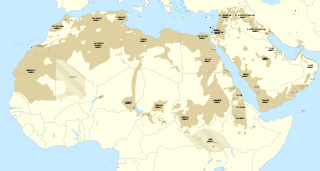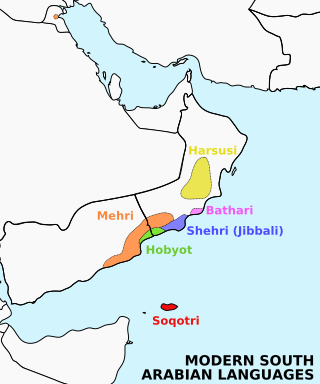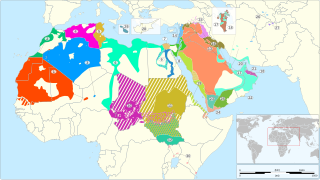
Arabic is a Central Semitic language of the Semitic language family spoken primarily in the Arab world. The ISO assigns language codes to 32 varieties of Arabic, including its standard form of Literary Arabic, known as Modern Standard Arabic, which is derived from Classical Arabic. This distinction exists primarily among Western linguists; Arabic speakers themselves generally do not distinguish between Modern Standard Arabic and Classical Arabic, but rather refer to both as al-ʿarabiyyatu l-fuṣḥā or simply al-fuṣḥā (اَلْفُصْحَىٰ).

The Semitic languages are a branch of the Afroasiatic language family. They include Arabic, Amharic, Aramaic, Hebrew, and numerous other ancient and modern languages. They are spoken by more than 330 million people across much of West Asia, North Africa, the Horn of Africa, Malta, and in large immigrant and expatriate communities in North America, Europe, and Australasia. The terminology was first used in the 1780s by members of the Göttingen school of history, who derived the name from Shem, one of the three sons of Noah in the Book of Genesis.

The Sabaeans or Sabeans were an ancient group of South Arabians. They spoke Sabaic, one of the Old South Arabian languages. They founded the kingdom of Sabaʾ in modern-day Yemen, which is considered to be the biblical land of Sheba and "the oldest and most important of the South Arabian kingdoms".

Classical Arabic or Quranic Arabic is the standardized literary form of Arabic used from the 7th century and throughout the Middle Ages, most notably in Umayyad and Abbasid literary texts such as poetry, elevated prose and oratory, and is also the liturgical language of Islam. Classical Arabic is, furthermore, the register of the Arabic language on which Modern Standard Arabic is based.

Yemeni Arabic is a cluster of varieties of Arabic spoken in Yemen and southwestern Saudi Arabia. It is generally considered a very conservative dialect cluster, having many classical features not found across most of the Arabic-speaking world.

The Himyarite Kingdom or Himyar, historically referred to as the Homerite Kingdom by the Greeks and the Romans, was a polity in the southern highlands of Yemen, as well as the name of the region which it claimed. Until 110 BCE, it was integrated into the Qatabanian kingdom, afterwards being recognized as an independent kingdom. According to classical sources, their capital was the ancient city of Zafar, relatively near the modern-day city of Sana'a. Himyarite power eventually shifted to Sana'a as the population increased in the fifth century. After the establishment of their kingdom, it was ruled by kings from dhū-Raydān tribe. The kingdom was named Raydān.
Old South Arabian (also known as Ancient South Arabian (ASA), Epigraphic South Arabian, Ṣayhadic, or Yemenite) is a group of four closely related extinct languages (Sabaean/Sabaic, Qatabanic, Hadramitic, Minaic) spoken in the far southern portion of the Arabian Peninsula. The earliest preserved records belonging to the group are dated to the beginning of the 1st millennium BCE. They were written in the Ancient South Arabian script.

Sabaic, sometimes referred to as Sabaean, was an Old South Arabian language that was spoken between c. 1000 BC and the 6th century AD by the Sabaeans. It was used as a written language by some other peoples of the ancient civilization of South Arabia, including the Ḥimyarites, Ḥashidites, Ṣirwāḥites, Humlanites, Ghaymānites, and Radmānites. Sabaic belongs to the South Arabian Semitic branch of the Afroasiatic language family. Sabaic is distinguished from the other members of the Old South Arabian group by its use of h to mark the third person and as a causative prefix; all of the other languages use s1 in those cases. Therefore, Sabaic is called an h-language and the others s-languages. Numerous other Sabaic inscriptions have also been found dating back to the Sabean colonization of Africa.
Abū Muḥammad al-Ḥasan ibn Aḥmad ibn Yaʿqūb al-Hamdānī was an Arab Muslim geographer, chemist, poet, grammarian, historian, and astronomer, from the tribe of Banu Hamdan, western 'Amran, Yemen. He was one of the best representatives of Islamic culture during the last period of the Abbasid Caliphate. His work was the subject of extensive 19th-century Austrian scholarship.

South Arabia is a historical region that consists of the southern region of the Arabian Peninsula in Western Asia, mainly centered in what is now the Republic of Yemen, yet it has also historically included Najran, Jizan, Al-Bahah, and 'Asir, which are presently in Saudi Arabia, and the Dhofar of present-day Oman.

Mehri or Mahri (مهريّت) is the most spoken of the Modern South Arabian languages (MSALs), a subgroup of the Semitic branch of the Afroasiatic family. It is spoken by the Mehri tribes, who inhabit isolated areas of the eastern part of Yemen, western Oman, particularly the Al Mahrah Governorate, with a small number in Saudi Arabia near the Yemeni and Omani borders. Up to the 19th century, speakers lived as far north as the central part of Oman.

Pre-Islamic Arabia, referring to the Arabian Peninsula before Muhammad's first revelation in 610 CE, is referred to in Islam in the context of jahiliyyah, highlighting the prevalence of paganism throughout the region at the time.

Ḥaḍramautic or Ḥaḍramitic was the easternmost of the four known languages of the Old South Arabian subgroup of the Semitic languages. It was used in the Kingdom of Hadhramaut and also the area round the Hadhramite capital of Shabwa, in what is now Yemen. The Hadramites also controlled the trade in frankincense through their important trading post of Sumhuram, now Khor Rori in the Dhofar Governorate, Oman.
Taʽizzi-Adeni Arabic or Southern Yemeni Arabic is a dialect of Arabic spoken primarily in Yemen. The dialect itself is further sub-divided into the regional vernaculars of Ta’izzi, spoken in Ta'izz, and Adeni, spoken in Aden.

Varieties of Arabic are the linguistic systems that Arabic speakers speak natively. Arabic is a Semitic language within the Afroasiatic family that originated in the Arabian Peninsula. There are considerable variations from region to region, with degrees of mutual intelligibility that are often related to geographical distance and some that are mutually unintelligible. Many aspects of the variability attested to in these modern variants can be found in the ancient Arabic dialects in the peninsula. Likewise, many of the features that characterize the various modern variants can be attributed to the original settler dialects as well as local native languages and dialects. Some organizations, such as SIL International, consider these approximately 30 different varieties to be separate languages, while others, such as the Library of Congress, consider them all to be dialects of Arabic.
Razihi, originally known to linguists as "Naẓīri", is a Central Semitic language spoken by at least 62,900 people in the vicinity of Mount Razih in the far northwestern corner of Yemen. Along with Faifi, it is possibly the only surviving descendant of the Old South Arabian languages.
Pre-Classical Arabic is the cover term for all varieties of Arabic spoken in the Arabian Peninsula until immediately after the Arab conquests in the 7th century C.E. Scholars disagree about the status of these varieties.
Faifi is a possible descendant of Old South Arabian language and is spoken by about 50,000 people in the vicinity of the Fifa Mountains in the southwestern corner of Saudi Arabia and across the border in Jebel Minabbih, Yemen. Along with Razihi, it is possibly the only other possible surviving descendant of the Old South Arabian branch of Central Semitic.
Salhin also spelled Silhin is a Sabaean palace that is located in Marib, Yemen. The exact location of the palace is still unknown due to the lack of excavations in Yemen. The palace is mentioned many times in South Arabian inscriptions as well as Arab traditions.

Rijāl Almaʿ is a speech variety of questionable genetic affiliation spoken in the area in and around the village after which it is named, Rijāl Almaʿ. Amongst the features that make this speech variety so distinctive in the area where it is spoken is the seemingly preserved demonstrative pronominal paradigm from the Sayhadic languages and the presence of the a nasal definite article similar to the proposed modern Sayhadic languages Faifi and Razihi. The speech variety is seemingly gradually being phased out due to increased language convergence with neighboring varieties of Arabic, further complicating the situation regarding where this speech variety belongs within Central Semitic.














